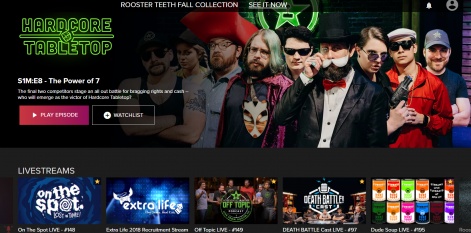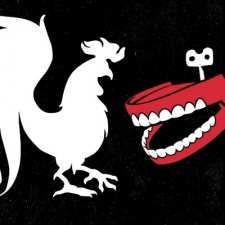“First post!!” was the first post. Earnest eyes refreshed the page of their new web series to read the inagural comment, to grasp at their first engagement with their audience.
For all you content creators out there, it’s a familiar feeling. But this was no YouTube page. Because in 2003, there was no YouTube.
When Rooster Teeth’s legendary machinima Red vs. Blue got a million views in its first month, there was no shower of internet cash. In fact, Rooster Teeth founder Burnie Burns said at a VidCon keynote that they received a bill for $12,000 just to fund the traffic into their servers. “The problem you want to have” was how Burns phrased it.
So how do you pay for being successful? The founders of Rooster Teeth gave viewers the chance to see their web-series episodes early, get exclusive merchandise and own physical copies, all for a monthly fee. This is still 2003 by the way. No YouTube Red, no Patreon, no Tidal, no Vessel.
Fifteen years on, Rooster Teeth is a gigantic entertainment empire holding billions of views over twelve different growing channels. They have produced feature action and horror films, sent the first American anime to Japan, created over 210 shows, and host huge conventions for fans all over the world.
So how did a few Texan dudes with one comment evolve into a global kingdom of variety content?
The economy of first
Rooster Teeth CEO Matt Hullum said to Digiday that “one of the most important things to our audience has always been the idea of getting things first - to see it, know about it and talk about it before others can.”
This is why Rooster Teeth have what they call the ‘economy of FIRST’. RT’s FIRST service, originally named RT Sponsorships, is a lot more than just an Subscription Video-On-Demand (SVOD) model.
If you’re a FIRST member on the Rooster Teeth site and pay $5 per month you can: see content early, get exclusive videos, series and livestreams, merchandise discounts, no ads, and more.
The reason I sound like a nightclub rep trying to get you to buy drinks right now is because this company’s values and story can provide a valuable lesson to businesses, influencers and creators alike. That lesson is that you should be providing for your audience, not for a platform.
Rooster Teeth are on their website, but also on YouTube, their mobile app, Apple TV, Xbox One, international cinema theatres, and more. The common denominator is the people, the fans, the watching eyes. Rooster Teeth was founded on giving their fans a premium and exclusive service, and they stuck to that.
But with crumbling advertisement revenue rates, cryptic and frustrating staff responses and copyright claim meltdowns, YouTube is something influencers are finding harder to stick with. Many creators use merchandise or sponsored brand deals for revenue and are reaching into subscription content.
As Matt Hullum says: “Online advertising rates can change. The cost of goods in merchandising can change. But when you have a subscription program and the loyalty of your fan base, it’s helped us maintain an even footing over the years.”
Behind the velvet curtain
This concept is generally used by others in the form of Patreon, the subscription platform founded in 2013. YouTube Red also gives exclusive shows and perks for a monthly fee. But Hullum isn’t talking about Patreon or YouTube Red, because it’s not the same as what they’re providing with FIRST.
FIRST is not just a money page with perks attached or mixed with other creators – it’s its own unique platform. It’s living and breathing. To see it in action, you can go on the Rooster Teeth website. At first glance, it can be a lot of things to take in, lines and lines of shows, channels, livestreams and merchandise.
One thing I instantly associated it with was Netflix, the most successful SVOD service out there. As I scroll, I notice again and again one icon, a small star. The content only FIRST members can watch. And every month it seems like the number of shows with that star attached is increasing at an accelerated rate.
Full television-standard narrative shows such as Day 5 and Crunch Time are cordoned off, along with their documentary series, panel podcasts and livestreams. Fans are not paying money to fund YouTube videos with some fun perks, these members are paying for their own exclusive layer of Rooster Teeth. That exclusivity feels cool and made me feel jealous of those that had access behind that red velvet rope – a feeling I believe Rooster Teeth are purposely curating for us.

Old ideas, new beginnings
This idea is not exclusive to Rooster Teeth, however. More and more influencers are jumping to subscription services, but some are going further. Earlier in 2018, Philip DeFranco guided his already gigantic sum of Patreon members to join him on his own interactive distribution platform, Defranco Now.
Influencers are not creating content for YouTube, or Vimeo, or Instagram. Influencers are creating content for their audience.
In a statement DeFranco said that “DeFranco Now is all about our amazing fan community and inviting them to be part of the show”. Sound familiar?
However, transitioning to this model isn’t that easy. Rooster Teeth may have pioneered these concepts a decade before anyone else, but to give most influencers some credit, once you’re on the YouTube train,it’s hard to get off. If you move to your own website or a different video platform, will people follow?
The answer to that depends on how you’re engaging with your audience. The factor connecting creators such as Rooster Teeth and Philip DeFranco is the loyalty and enthusiasm of their fanbases. How to keep fans engaged and loyal is a wide topic, and there is not one right answer.
Something to take from the idea of FIRST is to try and remove the middle-man between creator and audience. Influencers are not creating content for YouTube, or Vimeo, or Instagram. Influencers are creating content for their audience.
Rooster Teeth supply content to the platforms we like, but they’re successful because they’re always asking themselves how they can give their audience more. And it’s not just about the five-dollar monthly payment – if that’s all they cared about, they wouldn’t have the payment in the first place. It’s about putting the customer first, and meaning it.
While Rooster Teeth seem to stand apart from other companies and creators as an old god of sorts, they don’t have to be. As a previous YouTube creator, I can relate with these film students working out of a spare bedroom in 2003. Many of us know what it’s like, sending out content into the void, waiting for that first comment to come in. That first click.
The question that can make or break creators is this: what do you do with it?















